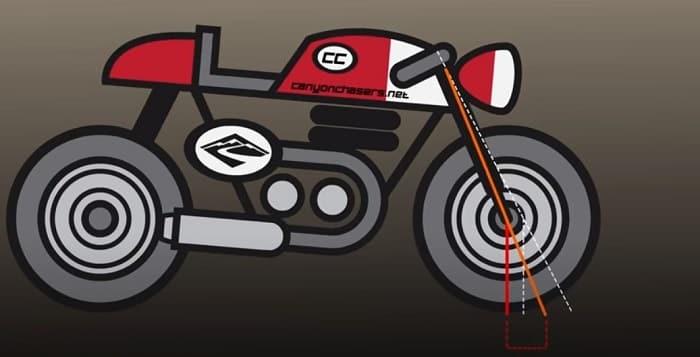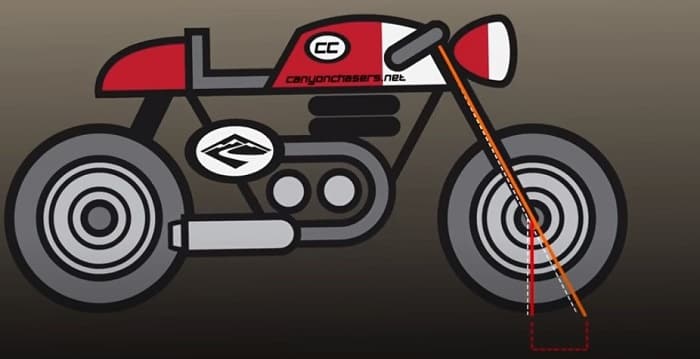You may have heard people say the trail braking is a race track only technique, but we would argue that trail braking is even more important for the street rider, especially while turning a corner.
I can honestly say that once I got my head around trail braking in a corner, it was one of the techniques that made some of the most dramatic improvements in my riding. Not only did it make it safer to turn the corner, but it also helped me accelerate faster out of the corner.
Why Do You Need Trail Braking?
Table of Contents
Trail braking helps the motorcycle change direction so that you
can get into and out of corners more efficiently. But more importantly, trail braking gives riders many more options for dealing with unpredictable conditions and unfamiliar corners.
When you enter a corner too fast, you have two choices; add a more lean angle, increase risk, or slow down.
Can You Brake While Turning The Motorcycle?
But we’ve all been told that going to the brakes in a corner is dangerous.
Trail braking is different.
What Is Trail Braking?
In the context of motorcycling, trail braking is trailing off the front brake as the motorcycle begins leaning. You are braking past the point where the motorcycle tips in, focusing on the front brake. Applying the rear brake while the bike is leaned over is extremely risky, so for clarity, trail braking is primarily a front brake technique.
Riders with motorcycles with linked brakes, fear not; your motorcycle will behave just fine for trail braking.
And no, this is not just a sport bike thing either. Trail braking works on
every kind of bike, from cruisers, touring bikes, adventure bikes, and even scooters.
Now, I know most beginner rider programs teach that you need to do most of the braking before the corner and then gradually accelerate through the rest of the turn.
And if you learned to ride in America, you probably had the phrase “Slow, Look, Press, and Roll” drilled into you by your rider coach.
But there are some real problems with this technique. First, if it’s a blind corner and you don’t know how tight it is, how do you know how much you need to slow so that you can gradually accelerate through the rest of the turn?
And if you don’t know how tight it is, how can you possibly know how much you can accelerate before you’re going too fast?
Second, why would you want to accelerate when you can’t see what’s ahead?
And finally, when you try to accelerate and turn, you are fighting two
opposing physics forces. Let’s talk about the physics part first.
When we slow, the weight of the motorcycle shifts forward, and the forks compress. When the forks compress, your wheelbase is shortened.

The rake and trail numbers decrease, and the motorcycle becomes less stable in a straight line, and now wants to change direction.
In effect, no matter what kind of motorcycle you’re on when you apply the brakes, your motorcycle becomes more like a sportbike.
Conversely, when we accelerate, the motorcycle’s weight shifts to the rear and the forks extend. The wheelbase becomes longer, and the rake and trail numbers increase.

Is trail Braking Safe?
Trail braking is safe because the motorcycle becomes more stable in that it wants to go straight. This means that you can manipulate the bike’s geometry to behave the way we want it to.
No matter what kind of bike you’re on when you accelerate, it becomes more like a cruiser.
One of my favorite moments of teaching out at the racetrack was when a student came up to me with a question.
He said to me in frustration, “I just can’t find a fast line through that corner.” And I had to explain to him, and there is no fast line through that corner.
It’s a slow corner. And herein lies the truth of motorcycling; the more gentle, or wider, the arc of the corner, the faster you can go through it.
And the tighter the corner, the slower you must go. Also, to counter steering, we can use the brakes to help us change direction.
Compressing the forks and altering the rake and trail to help the bike change direction, and slowing down, makes the circle smaller until we can see the corner’s exit.
If the turn is tighter than we anticipated, or there’s something unexpected in the corner, we are already slowing down. We are already on the brakes, so we have many options available to us.
We can slow even further. We can alter our path of travel. And we may even be able to stop in the middle of the corner if we need to.
If slowing alters the bike’s geometry and makes it want to change direction, and slowing makes that circle smaller, now is where we get to the fun part.
We can use the throttle to make the bike straighten up – make the circle bigger, and drive out of the corner.
This is the safest place to accelerate because we can see where
we are going, and we are trying to go straight.
Ideally, you should use the throttle to accelerate out of a corner and go just wide enough you end up on the outside of the corner.
Just don’t accelerate so earlier so aggressively that you end up running wide on the corner exit.
When you try to accelerate through an entire corner, you are giving the bike conflicting instructions. Accelerating alters the bike’s geometry, telling the bike to go straight.
You are gathering speed, which is increasing the radius of the corner,
making the circle bigger. Not to mention that accelerating when you can’t see what’s in front of you is what we would call “risky.”
Trail braking is working with the design and strengths of the motorcycle
to get to a corner with less risk and far more precision.
Your past instructors, or other riders, may have told you that braking in a corner is extremely dangerous. And it is.
Going to the brakes, especially just the rear brake, after the motorcycle is leaned over is extremely risky and should be avoided if at all possible.
But with trail braking, we’re not going to the brakes mid-corner. We go to the brake sooner, lighter, but carry the brakes for much longer.
If you’ve read our article “Seven Tips to Being a Faster, Safer Rider,” you may remember me saying, “the fastest riders use the brakes the most.”
This is quintessentially what that means. As we near the corner entrance, we ease off the rear brake and continue to drag, or trail, the front brake.
Ideally, we continue trailing on that front brake, even if we’re only using one percent of our total front brake’s ability until we arrive at the apex and we can see the exit of the corner.
Ok, I know what some of you are thinking’; you’re thinking, “I do that, but I coast into corners, and I accelerate back out.”
That’s good, but what do you do if the corner is tighter than you anticipated? Do you add more coast?
By using the brakes, we are the ones in charge. We determine if we want to brake more or less. We have ultimate control over our rate of forwarding velocity.
Coasting is engine braking, and engine braking is like braking with just the rear brake, which isn’t so good. Not to mention that engine braking negates all of the bike geometry benefits we get from using the front brake.
If this is brand-new to you and you want to start trying it out, start by using a squishy ball. Practice squeezing and releasing the ball slowly.
Extend this practice to every input you give your motorcycle.
It doesn’t matter if we’re moving the bike around in the garage or heading into a blind corner. Practice always gently squeezing the lever.
As you start practicing this on your daily rides, don’t go out and brake as hard as you can, all the way to the apex of the corner.
Start by riding like you normally do. Slowing before the corner, but begin by simply releasing the front brake lever far more slowly than you normally do.
This is a great way to learn how the brakes affect the motorcycle, and become comfortable with these techniques slowly, instead of all at once.
The tire can hold a lot of force, but not suddenly; if we get good at adding and subtracting brake force in small increments will get good at never overcooking a corner or running over that double yellow line again.


